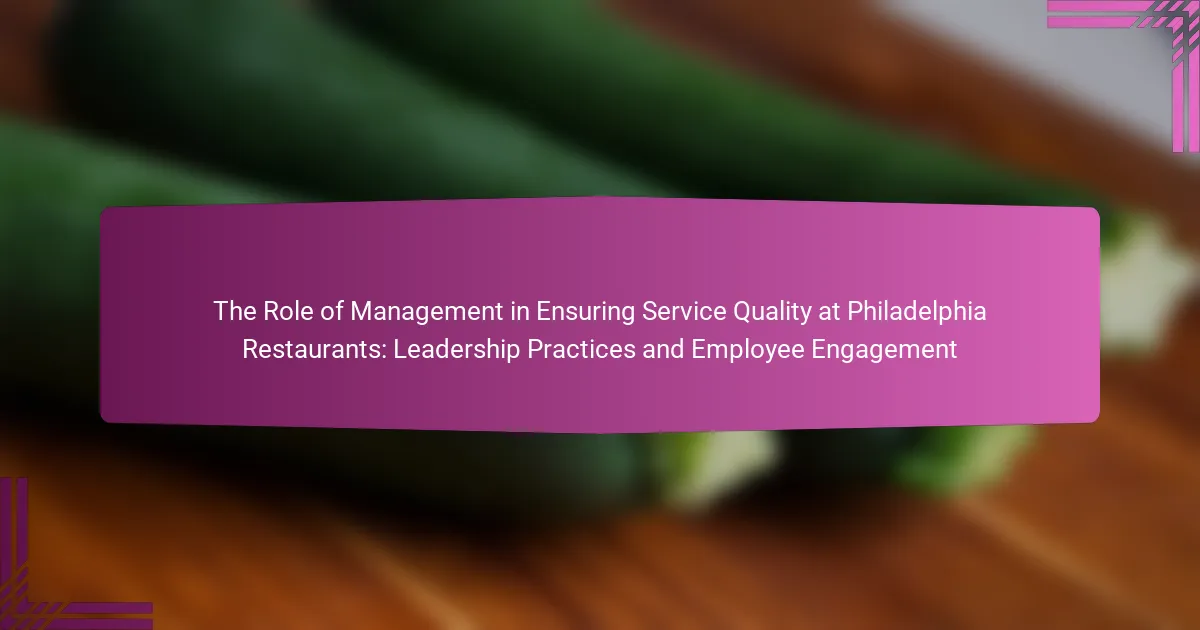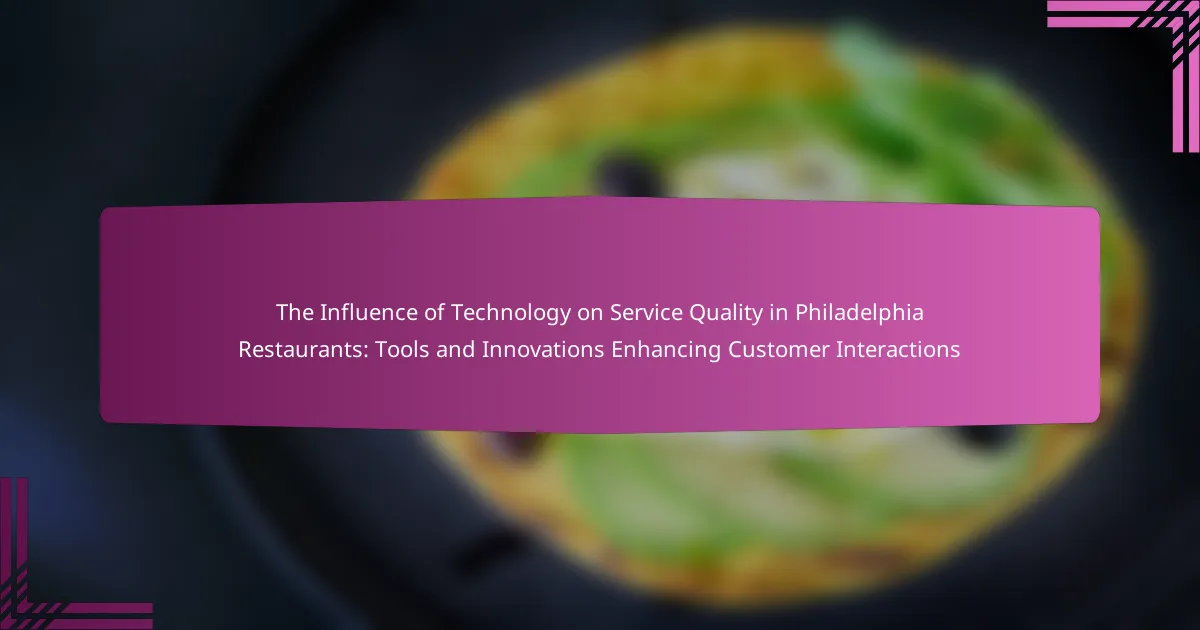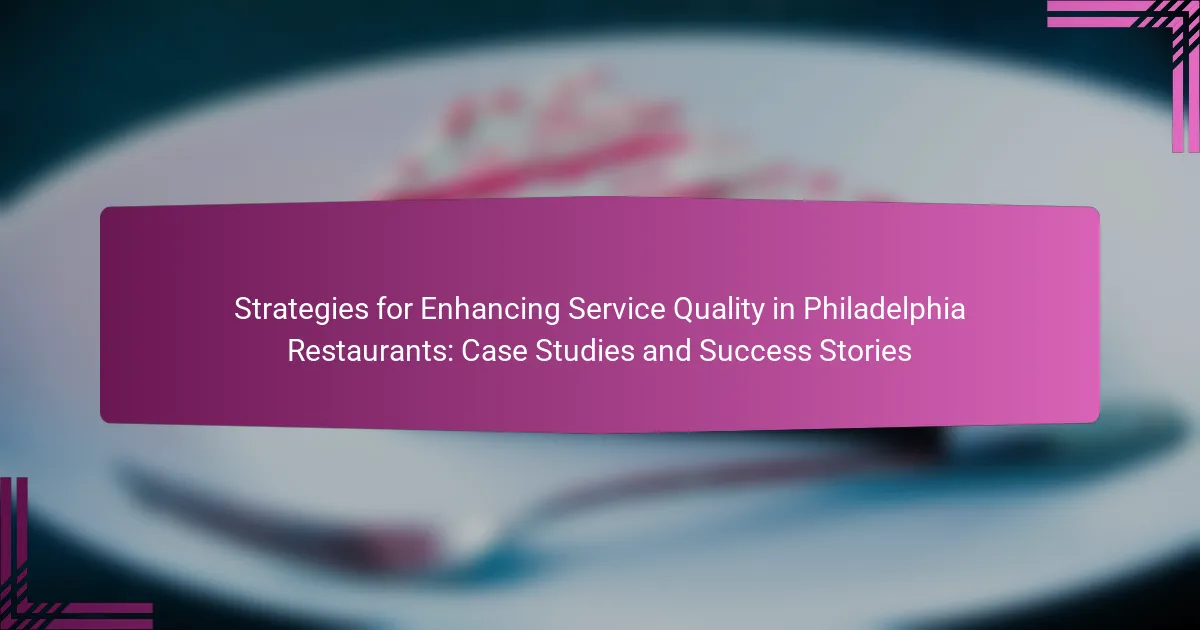
What is the role of management in ensuring service quality at Philadelphia restaurants?
Management plays a crucial role in ensuring service quality at Philadelphia restaurants. They establish standards and protocols for service delivery. This includes training staff to meet customer expectations. Management also monitors performance through customer feedback and service evaluations. Regular assessments help identify areas for improvement. Additionally, management fosters a positive work environment that encourages employee engagement. Engaged employees are more likely to provide high-quality service. According to a study by the National Restaurant Association, effective management practices directly correlate with improved customer satisfaction. This highlights the importance of management in maintaining service quality.
How do leadership practices influence service quality in restaurants?
Leadership practices significantly influence service quality in restaurants. Effective leadership fosters a positive work environment. This environment encourages staff to engage with customers more effectively. Leaders who prioritize training enhance employee skills. Skilled employees provide better service, leading to higher customer satisfaction. Research shows that restaurants with strong leadership have better service ratings. A study by Chen and Wu (2018) found that leadership style directly correlates with service quality. Transformational leadership, in particular, motivates employees to exceed customer expectations. Thus, leadership practices are critical in shaping service quality in the restaurant industry.
What specific leadership styles are most effective in the restaurant industry?
Transformational leadership and servant leadership are the most effective styles in the restaurant industry. Transformational leadership fosters motivation and engagement among staff. It encourages innovation and adaptability, crucial in a fast-paced environment. Servant leadership emphasizes serving employees first. This approach builds trust and improves team morale. Research indicates that these styles enhance employee satisfaction and retention. A study by Kwortnik and Thompson (2009) found that effective leadership directly correlates with service quality. This evidence supports the effectiveness of these leadership styles in achieving operational success in restaurants.
How do leaders set service quality standards in restaurants?
Leaders set service quality standards in restaurants by establishing clear expectations and guidelines. They define the desired level of service through training programs. These programs often include role-playing scenarios and customer service workshops. Leaders also implement regular evaluations to assess service delivery. Feedback from customers is gathered to identify areas for improvement. Additionally, leaders encourage employee engagement to foster a culture of service excellence. They recognize and reward staff who meet or exceed service standards. This approach ensures that service quality is consistently maintained across the restaurant.
Why is employee engagement important for service quality?
Employee engagement is crucial for service quality because it directly influences employee performance and customer satisfaction. Engaged employees are more likely to provide excellent service. They exhibit higher levels of enthusiasm and commitment to their roles. This results in better interactions with customers. Research indicates that businesses with high employee engagement can see a 20% increase in customer satisfaction scores. Additionally, engaged employees are less likely to leave their jobs. This reduces turnover costs and maintains service consistency. Overall, employee engagement fosters a positive work environment that enhances service quality.
What are the key factors that drive employee engagement in restaurants?
Key factors that drive employee engagement in restaurants include effective leadership, positive work culture, and recognition. Effective leadership fosters open communication and trust among staff. This encourages employees to feel valued and involved in decision-making. A positive work culture promotes teamwork and collaboration. Employees are more engaged when they work in a supportive environment. Recognition of employee contributions boosts morale and motivation. Studies show that restaurants with high employee engagement have lower turnover rates and better customer satisfaction. For instance, the Gallup State of the American Workplace report indicates that engaged employees lead to a 21% increase in profitability.
How does employee engagement impact customer satisfaction?
Employee engagement positively impacts customer satisfaction. Engaged employees are more motivated to provide excellent service. They tend to exhibit a higher level of commitment to their roles. This commitment translates into better customer interactions. Studies show that organizations with high employee engagement experience increased customer loyalty. For instance, a Gallup report indicates that businesses with engaged employees see 10% higher customer ratings. Thus, the relationship between employee engagement and customer satisfaction is significant and measurable.

What challenges do restaurant managers face in maintaining service quality?
Restaurant managers face several challenges in maintaining service quality. High employee turnover affects consistency in service delivery. According to a study by the National Restaurant Association, turnover rates in the restaurant industry can exceed 70%. This leads to a lack of experienced staff, which can degrade customer service.
Inadequate training programs also contribute to service quality issues. When new employees are not properly trained, they may struggle to meet customer expectations. Furthermore, managers often deal with varying customer demands, which can create pressure on staff.
Time management is another critical challenge. Managers must balance operational tasks while ensuring staff provide excellent service. Additionally, customer feedback can be inconsistent, making it difficult to gauge service quality.
Lastly, external factors such as supply chain disruptions can impact service quality. These challenges require managers to be proactive and adaptable to maintain high service standards.
How do external factors affect service quality in Philadelphia restaurants?
External factors significantly affect service quality in Philadelphia restaurants. These factors include economic conditions, competition, and customer demographics. Economic downturns can lead to reduced consumer spending, impacting restaurant revenues and service quality. High competition in the area forces restaurants to enhance their service offerings to attract customers. Additionally, diverse customer demographics influence service expectations and preferences. For instance, younger customers may prioritize speed and convenience, while older customers might value personalized service. Weather conditions can also affect customer turnout, impacting the overall dining experience. A study by the National Restaurant Association highlights that external economic factors can lead to changes in service quality and customer satisfaction levels.
What role does competition play in shaping service quality?
Competition significantly influences service quality by driving businesses to enhance their offerings. When multiple restaurants compete, they strive to differentiate themselves through superior service. This leads to increased customer expectations and demands for better experiences. As a result, restaurants implement training programs for staff and invest in customer service technologies. Research shows that in competitive markets, businesses that fail to improve service quality risk losing customers. For example, a study by the National Restaurant Association indicates that 70% of customers are willing to switch to competitors for better service. Thus, competition serves as a catalyst for continuous improvement in service quality.
How do economic conditions influence restaurant management practices?
Economic conditions significantly influence restaurant management practices. During economic downturns, restaurants often reduce costs by adjusting staffing levels. They may implement stricter budget controls and focus on efficiency. In contrast, during economic booms, restaurants may expand their offerings and invest in staff training. Consumer spending patterns also affect menu pricing strategies. Research indicates that 60% of restaurants adjust their menus based on economic indicators. Additionally, economic conditions impact supply chain decisions, influencing ingredient sourcing and pricing. Overall, restaurant management adapts to economic changes to maintain profitability and service quality.
What strategies can managers implement to enhance service quality?
Managers can implement several strategies to enhance service quality in restaurants. First, they should invest in staff training programs. Effective training improves employee skills and confidence in service delivery. Additionally, managers should establish clear service standards. These standards guide employees in providing consistent and high-quality service.
Regular feedback mechanisms are also crucial. Managers can conduct surveys to gather customer insights. This data helps identify areas for improvement. Furthermore, fostering a positive work environment boosts employee morale. Happy employees are more likely to deliver exceptional service.
Another strategy is to encourage teamwork among staff. Collaborative efforts enhance communication and efficiency during service. Managers should also recognize and reward outstanding performance. Recognition motivates employees to maintain high service standards.
Finally, leveraging technology can streamline service processes. Tools like reservation systems and mobile ordering improve customer experience. These strategies collectively contribute to enhanced service quality in Philadelphia restaurants.
How can training and development improve employee performance?
Training and development improve employee performance by enhancing skills and knowledge. Employees gain the necessary competencies to perform their tasks effectively. This leads to increased productivity and efficiency. According to a study by the Association for Talent Development, organizations with comprehensive training programs see a 218% higher income per employee. Furthermore, trained employees are more engaged and satisfied in their roles. This boosts morale and reduces turnover rates. When employees feel competent, they provide better customer service. Improved service quality directly impacts customer satisfaction and loyalty.
What role does feedback play in service quality improvement?
Feedback is crucial for service quality improvement. It helps identify areas needing enhancement. Feedback from customers provides insights into their experiences. This information enables management to make informed decisions. Regularly collecting feedback fosters a culture of continuous improvement. Studies show that businesses responding to feedback see increased customer satisfaction. For instance, a report by the American Customer Satisfaction Index indicates that companies acting on feedback improve service quality significantly. Thus, feedback is a vital tool for enhancing service quality in restaurants.

How can management foster a culture of service excellence in restaurants?
Management can foster a culture of service excellence in restaurants by prioritizing employee training and development. This ensures that staff are equipped with the necessary skills to deliver high-quality service. Regular training sessions can enhance employees’ knowledge about menu items and customer service techniques.
Additionally, management should create an environment that encourages open communication. This allows staff to share feedback and ideas for improving service. Acknowledging and rewarding exceptional service can motivate employees to maintain high standards.
Implementing consistent service standards across the organization is also crucial. This helps to establish clear expectations for staff behavior and performance. Management should lead by example, demonstrating a commitment to service excellence in their interactions with both employees and customers.
Research shows that a positive workplace culture directly correlates with customer satisfaction. According to a study by the Cornell University School of Hotel Administration, restaurants with engaged employees see a 20% increase in customer satisfaction scores. This reinforces the importance of management’s role in fostering a service-oriented culture.
What practices promote a customer-centric approach among staff?
Training staff on customer service skills promotes a customer-centric approach among staff. This training enhances communication and problem-solving abilities. Regular workshops on empathy and active listening are effective. Implementing role-playing scenarios can simulate real customer interactions. Encouraging staff feedback fosters a sense of ownership in service quality. Recognizing and rewarding customer-centric behaviors motivates employees. Establishing clear customer service standards guides staff actions. Monitoring customer feedback helps identify areas for improvement.
How can recognition and rewards enhance employee motivation?
Recognition and rewards enhance employee motivation by acknowledging individual contributions and fostering a positive work environment. When employees receive recognition, it reinforces their value within the organization. This acknowledgment can lead to increased job satisfaction and loyalty. Research shows that companies with effective recognition programs see a 31% lower voluntary turnover rate. Rewards, such as bonuses or incentives, provide tangible benefits that encourage higher performance levels. According to a Gallup study, employees who feel appreciated are 3 times more likely to be engaged in their work. Ultimately, recognition and rewards create a culture of appreciation that motivates employees to excel.
What are the best practices for effective communication in restaurant teams?
Effective communication in restaurant teams involves clear, concise messaging and active listening. Teams should hold regular meetings to discuss daily goals and challenges. Utilizing technology, such as messaging apps, can streamline communication. Encouraging feedback fosters an open environment. Training staff on communication skills enhances interaction. Assigning roles clarifies responsibilities and reduces confusion. Implementing a chain of command ensures messages are conveyed efficiently. A study by the National Restaurant Association highlights that effective communication improves team performance and service quality.
What are the practical steps for managers to ensure high service quality?
Managers can ensure high service quality by implementing specific strategies. First, they should establish clear service standards. These standards guide employee behavior and set customer expectations. Second, regular training sessions are essential. Training enhances employees’ skills and knowledge about service delivery. Third, managers must monitor performance consistently. This includes observing interactions and gathering customer feedback. Fourth, they should foster a positive work environment. A supportive atmosphere boosts employee morale and engagement. Fifth, managers need to empower employees. Allowing staff to make decisions can improve service responsiveness. Lastly, recognizing and rewarding excellent service is vital. This encourages a culture of quality and motivates employees to excel.
How can managers conduct regular service quality assessments?
Managers can conduct regular service quality assessments by implementing structured evaluation methods. They should establish clear service standards based on customer expectations. Surveys can be distributed to gather customer feedback on their experiences. Observational assessments can be performed during service interactions to evaluate employee performance. Managers can also conduct mystery shopper programs to gain unbiased insights. Regular training sessions can help employees understand service quality expectations. Analyzing service metrics, such as wait times and customer satisfaction scores, is essential. Continuous improvement strategies should be developed based on assessment findings. This approach ensures that service quality remains aligned with customer needs and preferences.
What tools and metrics can be used to measure service quality effectively?
Service quality can be effectively measured using tools such as customer satisfaction surveys, Net Promoter Score (NPS), and service quality assessments like SERVQUAL. Customer satisfaction surveys gather direct feedback from patrons regarding their dining experience. NPS measures customer loyalty by asking how likely customers are to recommend the restaurant. SERVQUAL evaluates service quality based on five dimensions: tangibles, reliability, responsiveness, assurance, and empathy. These tools provide quantifiable data that can be analyzed for insights. Studies show that restaurants utilizing these metrics can enhance service quality and improve customer retention.
What tips can restaurant managers follow to improve service quality?
Restaurant managers can improve service quality by focusing on staff training and customer feedback. Providing regular training sessions enhances employee skills and service consistency. Managers should also encourage open communication among staff to address issues promptly. Implementing a customer feedback system helps identify areas needing improvement. Recognizing and rewarding excellent service motivates employees to maintain high standards. Managers can utilize technology for efficient order processing and communication. Regularly reviewing service standards ensures alignment with customer expectations. These strategies lead to increased customer satisfaction and loyalty.
The primary entity of this article is management in Philadelphia restaurants, specifically focusing on its role in ensuring service quality through effective leadership practices and employee engagement. The article examines how management establishes service standards, trains staff, and fosters a positive work environment to enhance customer satisfaction. It highlights the influence of leadership styles, particularly transformational and servant leadership, on service quality and employee engagement. Additionally, the article addresses the challenges restaurant managers face in maintaining service quality and outlines strategies for improvement, emphasizing the importance of feedback, recognition, and effective communication.



